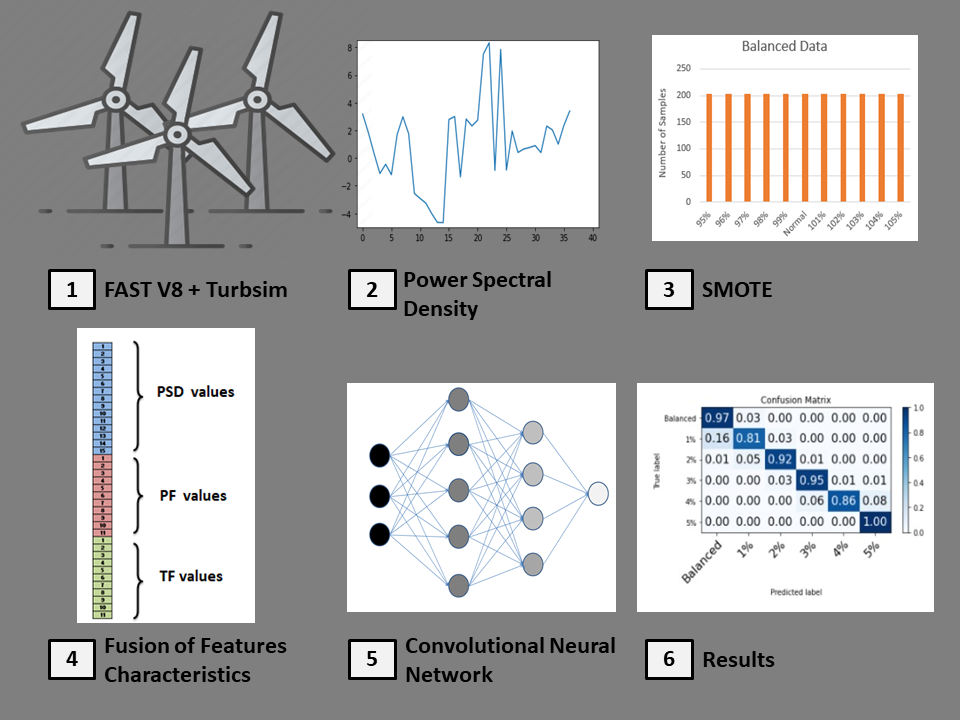Convolutional Neural Networks using the SMOTE Algorithm and Features Fusion for Wind Turbine Fault Prediction
Keywords:
Machine Learning, Convolutional Neural Networks, Wind turbine faul detection, Wind turbine failure predictAbstract
This research introduces an innovative method using Convolutional Neural Networks (CNNs) to identify mass imbalances in wind turbine rotors through a feature fusion strategy. To address the issue of class imbalance, the Synthetic Minority Oversampling Technique (SMOTE) is applied. A detailed simulation was carried out using a 1.5 MW three-bladed Wind Turbine model, employing tools such as Turbsim, FAST, and Matlab Simulink, to collect rotor speed data under different wind conditions. Mass imbalances were simulated by modifying blade density in the software. The fusion architecture combines feature extraction with Power Spectral Density analysis, improving the CNN’s ability to work across both frequency and time domains. The effectiveness of this approach was confirmed through a comparative analysis with 9 classifiers and 4 different dataset combinations, demonstrating its capability in detecting mass imbalances.
Downloads
References
G. W. E. Council, “Gwec global wind report 2021,” Global Wind Energy
Council: Brussels, Belgium, 2021.
X. Chen, X. Zhang, M. Dong, L. Huang, Y. Guo, and S. He, “Deep
learning-based prediction of wind power for multi-turbines in a wind
farm,” Frontiers in Energy Research, p. 403, 2021. doi:https://doi.org/
3389/fenrg.2021.723775.
M. Kaasik and S. Mirme, “Wind: generating power and cooling the
power lines,” Advances in Science and Research, vol. 17, pp. 105–108,
doi:https://doi.org/10.5194/asr-17-105-2020.
S.-Y. Cho, S.-K. Choi, J.-G. Kim, and C.-H. Cho, “An experimental
study of the optimal design parameters of a wind power tower used to
improve the performance of vertical axis wind turbines,” Advances in
Mechanical Engineering, vol. 10, no. 9, p. 1687814018799543, 2018.
doi:https://doi.org/10.1177/1687814018799543.
X. Gong and W. Qiao, “Imbalance fault detection of direct-drive wind
turbines using generator current signals,” IEEE Transactions on energy
conversion, vol. 27, no. 2, pp. 468–476, 2012. doi:https://doi.org/10.
/PESMG.2013.6672920.
J. Wang, Y. Liang, Y. Zheng, R. X. Gao, and F. Zhang, “An integrated
fault diagnosis and prognosis approach for predictive maintenance of
wind turbine bearing with limited samples,” Renewable Energy, vol. 145,
pp. 642–650, 2020. doi:http://dx.doi.org/10.1016/j.renene.2019.06.103.
L. Mishnaevsky Jr, “Repair of wind turbine blades: Review of methods
and related computational mechanics problems,” Renewable energy,
vol. 140, pp. 828–839, 2019. doi:https://doi.org/10.1016/j.renene.2019.
113.
Q. Gao, W. Liu, B. Tang, and G. Li, “A novel wind turbine fault
diagnosis method based on intergral extension load mean decomposition
multiscale entropy and least squares support vector machine,” Renewable
energy, vol. 116, pp. 169–175, 2018. doi:https://doi.org/10.1016/j.
renene.2017.09.061.
Y. Li, W. Jiang, G. Zhang, and L. Shu, “Wind turbine fault diagnosis
based on transfer learning and convolutional autoencoder with smallscale
data,” Renewable Energy, vol. 171, pp. 103–115, 2021. doi:https:
//doi.org/10.1016/j.renene.2021.01.143.
S. Cho, M. Choi, Z. Gao, and T. Moan, “Fault detection and diagnosis
of a blade pitch system in a floating wind turbine based on kalman filters
and artificial neural networks,” Renewable Energy, vol. 169, pp. 1–13,
doi:https://doi.org/10.1016/j.renene.2020.12.116.
H. Malik and S. Mishra, “Artificial neural network and empirical mode
decomposition based imbalance fault diagnosis of wind turbine using
turbsim, fast and simulink,” IET Renewable Power Generation, vol. 11,
no. 6, pp. 889–902, 2017. doi: https://doi.org/10.1049/iet-rpg.2015.0382.
Y. Chang, J. Chen, C. Qu, and T. Pan, “Intelligent fault diagnosis of
wind turbines via a deep learning network using parallel convolution
layers with multi-scale kernels,” Renewable Energy, vol. 153, pp. 205–
, 2020. doi:https://doi.org/10.1016/j.renene.2020.02.004.
J. Zeng and B. Song, “Research on experiment and numerical simulation
of ultrasonic de-icing for wind turbine blades,” Renewable Energy,
vol. 113, pp. 706–712, 2017. doi:https://doi.org/10.1016/j.renene.2017.
045.
G. Hübner, H. Pinheiro, C. de Souza, C. Franchi, L. da Rosa, and J. Dias,
“Detection of mass imbalance in the rotor of wind turbines using support
vector machine,” Renewable Energy, 2021. doi: https://doi.org/10.1016/
j.renene.2021.01.080.
N. V. Chawla, K. W. Bowyer, L. O. Hall, and W. P. Kegelmeyer,
“Smote synthetic minority oversampling technique,” Journal Of Artificial
Intelligence Research, vol. 16, pp. 321–357, 2002. doi:https:
//doi.org/10.1613/jair.953.
H. He and E. A. Garcia, “Learning from imbalanced data,” IEEE
Transactions on Knowledge and Data Engineering, vol. 21, no. 9,
pp. 1263–1284, 2009. doi:https://doi.org/10.1109/TKDE.2008.239.
B. Yegnanarayana, “Artificial neural networks for pattern recognition,”
vol. 19, pp. 189–238, 1994. doi:https://doi.org/10.1007/BF02811896.
H. Ramchoun, M. J. Idrissi, Y. Ghanou, and M. Ettaouil, “Multilayer
perceptron: Architecture optimization and training,” Int. J. Interact.
Multim. Artif. Intell., vol. 4, pp. 26–30, 2016. doi:https://doi.org/10.
/ijimai.2016.415.
S. Albawi, T. Mohammed, and S. Al-Zawi, “Understanding of a convolutional
neural network,” 2017 International Conference on Engineering
and Technology (ICET), pp. 1–6, 2017. doi:https://doi.org/10.1109/
ICEngTechnol.2017.8308186.
G. Huang, Z. Liu, L. Van Der Maaten, and K. Q. Weinberger, “Densely
connected convolutional networks,” in 2017 IEEE Conference on Computer
Vision and Pattern Recognition (CVPR), pp. 2261–2269, 2017.
doi:https://doi.org/10.1109/CVPR.2017.243.
D. Scherer, A. Müller, and S. Behnke, “Evaluation of pooling operations
in convolutional architectures for object recognition,” in Artificial Neural
Networks – ICANN 2010 (K. Diamantaras, W. Duch, and L. S. Iliadis,
eds.), (Berlin, Heidelberg), pp. 92–101, Springer Berlin Heidelberg,
doi:https://doi.org/10.1007/978-3-642-15825-4_10.
S. Park and N. Kwak, “Analysis on the dropout effect in convolutional
neural networks,” in Asian Conference on Computer Vision, 2016.
doi:https://doi.org/10.1007/978-3-319-54184-6_12.
P. Welch, “The use of fast fourier transform for the estimation of power
spectra: A method based on time averaging over short, modified periodograms,”
IEEE Transactions on Audio and Electroacoustics, vol. 15,
no. 2, pp. 70–73, 1967. doi:https://doi.org/10.1109/TAU.1967.1161901.
R. N. Youngworth, B. B. Gallagher, and B. L. Stamper, “An overview
of power spectral density (PSD) calculations,” in Optical Manufacturing
and Testing VI (H. P. Stahl, ed.), vol. 5869, pp. 206 – 216, International
Society for Optics and Photonics, SPIE, 2005.
Z. Wang and T. Oates, “Imaging time-series to improve classification
and imputation,” in Proceedings of the 24th International Conference
on Artificial Intelligence, IJCAI’15, p. 3939–3945, AAAI Press, 2015.
O. Gecgel, S. Ekwaro-Osire, J. P. Dias, A. Serwadda, F. M. Alemayehu,
and A. Nispel, “Gearbox fault diagnostics using deep learning with
simulated data,” in 2019 IEEE International Conference on Prognostics
and Health Management (ICPHM), pp. 1–8, 2019. doi:10.1109/ICPHM.
8819423.


